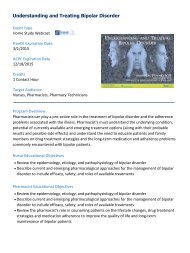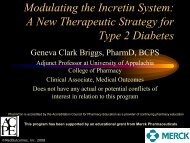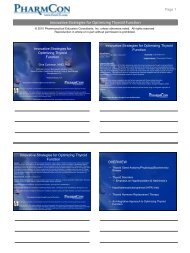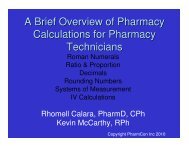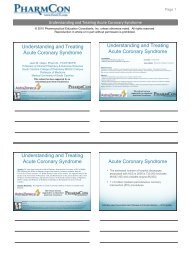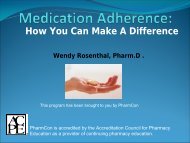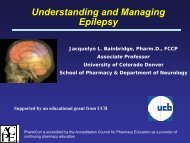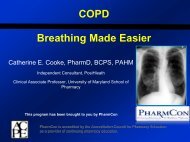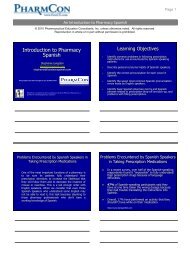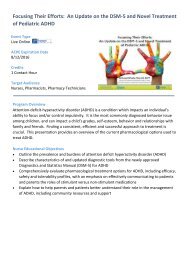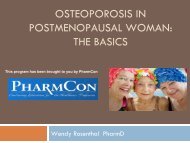Gout - Free CE Continuing Education online pharmacy, pharmacists
Gout - Free CE Continuing Education online pharmacy, pharmacists
Gout - Free CE Continuing Education online pharmacy, pharmacists
You also want an ePaper? Increase the reach of your titles
YUMPU automatically turns print PDFs into web optimized ePapers that Google loves.
Purdue University<br />
School of Pharmacy<br />
and Pharmaceutical<br />
Sciences and<br />
PharmCon Inc are accredited by<br />
the Accreditation Council for<br />
Pharmacy <strong>Education</strong> as a<br />
provider of continuing <strong>pharmacy</strong><br />
education. The ACPE Universal<br />
Program Number assigned to the<br />
program by the accredited<br />
providers is: 798-999-08-075-L01-P.<br />
This activity is jointly sponsored<br />
by PharmCon, Purdue<br />
University School of Pharmacy<br />
and Pharmaceutical Sciences,<br />
and The Customer Link, Inc.<br />
This activity is supported by an<br />
educational grant from Takeda<br />
Pharmaceuticals North America,<br />
Inc.
Speaker : Dr. Randolph V. Fugit is an Internal Medicine Clinical Specialist at the Denver<br />
Veterans Affairs Medical Center as well as Adjoint Assistant Professor in the Department of<br />
Pharmacy Practice at the University of Colorado Health Sciences Center School of Pharmacy.<br />
Dr. Fugit received his Doctor of Pharmacy degree from the University of New Mexico College<br />
of Pharmacy. His areas of research include pharmacoeconomics and outcomes research<br />
(including clinical pathway development) involved in the management of both acute and<br />
chronic disease states in gastroenterology, rheumatology, infectious diseases, cardiology,<br />
and pulmonology.<br />
Speaker Disclosure:<br />
Dr. Fugit reported that he is a consultant to Takeda Pharmaceuticals North America,<br />
Inc. and Cubist Pharmaceuticals, Inc. He also reported that he is a speaker for Pfizer<br />
Inc.; Boehringer Ingelheim Corporation; Cubist Pharmaceuticals, Inc.; Astellas<br />
Pharma US, Inc.; and sanofi-aventis U.S. LLC.<br />
Legal Disclaimer: The material presented here does not necessarily reflect the views of Pharmaceutical<br />
<strong>Education</strong> Consultants (PharmCon) or the companies that support educational programming. A qualified<br />
healthcare professional should always be consulted before using any therapeutic product discussed.<br />
Participants should verify all information and data before treating patients or employing any therapies<br />
described in this educational activity
This activity is supported by an<br />
educational grant from Takeda<br />
Pharmaceuticals North America,<br />
Inc.<br />
Accreditation:<br />
Pharmacist –798-999-08-075-L01-P<br />
Technicians- 798-999-08-075-L01-T<br />
<strong>CE</strong> Credits:<br />
1.0 Credit hour or 0.1 <strong>CE</strong>U for <strong>pharmacists</strong>/technicians<br />
Target Audience: Pharmacists & Technicians<br />
Program Overview: <strong>Gout</strong> is an enigma facing health care professionals today. Although it is an<br />
ancient disease with centuries of clinical experience, gout’s incidence and prevalence continues<br />
to rise owing to risk factors such as obesity from today’s more sedentary lifestyles. New<br />
epidemiological issues such as the association between hyperuricemia and cardiovascular<br />
disease also are now coming to the forefront in gout diagnosis and management.<br />
Objectives:<br />
• Recognize the general clinical presentations of gout, differentiating between acute attacks and<br />
chronic underlying disease<br />
• Advise patients about lifestyle interventions for the prevention and management of gout, focusing<br />
on the importance of weight loss and dietary modifications<br />
• Implement a patient education program for gout to improve knowledge about the disease state,<br />
the importance of adherence to medications, and patient commitment to treatment<br />
• Counsel patients about the appropriate medications to be used for acute and chronic gout, with a<br />
special focus on comorbidities, medication contraindications, and drug interactions and advise<br />
when a physician visit is necessary
Learning Objectives<br />
• Recognize the general clinical presentations of gout,<br />
differentiating between acute attacks and chronic underlying<br />
disease<br />
• Advise patients about lifestyle interventions for the prevention<br />
and management of gout, focusing on the importance of weight<br />
loss and dietary modifications<br />
• Implement a patient education program for gout to improve<br />
knowledge about the disease state, the importance of<br />
adherence to medications, and patient commitment to<br />
treatment<br />
• Counsel patients about the appropriate medications to be used<br />
for acute and chronic gout, with a special focus on<br />
comorbidities, medication contraindications, and drug<br />
interactions, and advise when a physician visit is necessary
Understanding<br />
the Role of Uric Acid<br />
and Hyperuricemia<br />
for the Development of<br />
<strong>Gout</strong>
How Prevalent Is <strong>Gout</strong> Compared<br />
to Other Common Conditions?<br />
Lupus<br />
Rheumatoid arthritis<br />
Prostate cancer<br />
Breast cancer<br />
Liver disease<br />
Kidney disease<br />
Fibromyalgia<br />
<strong>Gout</strong><br />
Stroke<br />
<strong>Gout</strong> affects<br />
5 million adults in<br />
the United States 1<br />
0 1 2 3 4 5 6 7<br />
Adults in the United States (millions) 1-6<br />
• <strong>Gout</strong> is the most common inflammatory joint disease in men aged<br />
> 40 years 7<br />
• 3.9 million annual physician visits in the United States for gout; twothirds<br />
at the primary care practitioner’s office 8<br />
1<br />
Kramer HM and Curhan G. Am J Kidney Dis. 2002;40:37-42. 2 Lethbridge-Cejku M, et al. Vital Health Stat. 2006;10(228).<br />
3<br />
Lawrence RC, et al. Arthritis Rheum. 2008;58:26-35. 4 Helmick CG, et al. Arthritis Rheum. 2008;58:15-25.<br />
5<br />
Rahman A and Isenberg DA. N Engl J Med. 2008;358:929-939. 6 American Heart Association Web site.<br />
http://www.americanheart.org/downloadable/heart/1200078608862HS_Stats%202008.final.pdf. Accessed November 19,<br />
2008. 7 Roubenoff R. Rheum Dis Clin North Am. 1990;16:539-550. 7 Krishnan E, et al. J Rheumatol. 2008;35:498-501.
Uric Acid, Hyperuricemia, and <strong>Gout</strong><br />
• Uric acid (urate) is the end product of purine<br />
degradation in humans 1<br />
• Hyperuricemia is a serum urate concentration in<br />
excess of urate solubility (≥ 6.8 mg/dL) 2<br />
– Results from underexcretion and/or overproduction of<br />
uric acid 3<br />
• <strong>Gout</strong> is the disease state resulting from deposition<br />
of MSU crystals in tissues 4<br />
1 Hahn PC, et al. In: Arthritis and Allied Conditions. 15th ed. 2005:2341-2355.<br />
2<br />
Schumacher HR Jr. Cleve Clin J Med. 2008;75(suppl 5):S2-S4.<br />
3<br />
Becker MA, et al. In: Arthritis and Allied Conditions. 15th ed. 2005:2303-2339.<br />
4 Eggebeen AT. Am Fam Physician. 2007;76:801-808.
Uric Acid: End Product of Purine<br />
Degradation in Humans<br />
Purine<br />
nucleotides<br />
Purine<br />
nucleosides<br />
N<br />
OH<br />
N<br />
Hypoxanthine<br />
Solubility decreases<br />
N<br />
N<br />
H<br />
Xanthine<br />
oxidase<br />
OH<br />
N<br />
OH<br />
N<br />
Xanthine<br />
N<br />
N<br />
H<br />
Xanthine<br />
oxidase<br />
OH<br />
N<br />
OH<br />
N<br />
Uric acid<br />
N<br />
N<br />
H<br />
HO<br />
Uricase<br />
Uricase:<br />
▪ Humans lost enzyme<br />
during evolution<br />
H 2 N<br />
O<br />
O<br />
N<br />
H<br />
NH<br />
N<br />
H<br />
O<br />
Allantoin<br />
Hahn PC, et al. In: Arthritis and Allied Conditions. 15th ed. 2005:2341-2355.
Distribution of Serum Urate Values and<br />
Hyperuricemia<br />
40<br />
Development of MSU<br />
crystals associated with 1<br />
• Decreased solubility of urate<br />
(temperature)<br />
• Low pH<br />
• Trauma or tissue injury<br />
• Supersaturation due to<br />
reabsorption of water (lack of<br />
joint activity during sleep)<br />
Percent of distribution 2<br />
35<br />
30<br />
25<br />
20<br />
15<br />
10<br />
Women<br />
Men<br />
Urate<br />
crystallizes<br />
at a level<br />
of 6.8<br />
mg/dL 3<br />
5<br />
0<br />
0 1 2 3 4 5 6 7 8 9 10 11 12 13<br />
Serum urate (mg/dL)*<br />
* Serum urate levels in 1515 men<br />
and 1670 women aged ≥ 30 years in<br />
Taiwan; 1991-1992<br />
1<br />
Dalbeth N and Haskard DO. Rheumatology. 2005;44:1090-1096.<br />
2 Lin K-C, et al. J Rheumatol. 2000;27:1045-1050.<br />
3<br />
Schumacher HR Jr. Cleve Clin J Med. 2008;75(suppl 5):S2-S4.
Medications Altering Urate Levels<br />
Urate-Increasing Agent 1<br />
Pyrazinamide<br />
Nicotinate<br />
Lactate, β-hydroxybutyrate,<br />
acetoacetate<br />
Salicylate (low dose)<br />
Ethambutol<br />
Diuretics<br />
Cyclosporine<br />
Tacrolimus<br />
β-blockers<br />
Urate-Decreasing Agent 1<br />
Uricosurics:<br />
Probenecid<br />
Losartan<br />
Salicylate (high dose)<br />
Fenofibrate<br />
Amlodipine<br />
Xanthine oxidase inhibitor:<br />
Allopurinol<br />
Febuxostat<br />
Uricase<br />
Other components may also affect uric acid clearance 1-3<br />
excessive alcohol intake, niacin, levodopa, cytotoxic drugs, and vitamin B 12<br />
1 Choi HK, et al. Ann Intern Med. 2005;143:499-516.<br />
2 Quiceno GA and Cush JJ. Rheum Dis Clin North Am. 2007;33:123-134. 3 Peronato G. Contrib Nephrol. 2005;147:1-21.
The Hyperuricemia Cascade<br />
Dietary<br />
purines<br />
Tissue<br />
nucleic acids<br />
Endogenous<br />
purine synthesis<br />
Overproduction<br />
5%-10% of all gout<br />
patients<br />
Urate<br />
Hyperuricemia<br />
Underexcretion<br />
80%-90% of all gout<br />
patients!<br />
Most common<br />
cause of<br />
hyperuricemia<br />
Silent<br />
tissue<br />
deposition<br />
<strong>Gout</strong><br />
Renal<br />
manifestations<br />
Associated<br />
cardiovascular<br />
events<br />
and mortality<br />
Becker MA, et al. In: Arthritis and Allied Conditions. 15th ed. 2005:2303-2339.<br />
Wortmann RL. In: Harrison’s Principles of Internal Medicine. 14th ed. 1998:2158-2165.<br />
Hahn PC, et al. In: Arthritis and Allied Conditions. 15th ed. 2005:2341-2355.<br />
Pittman JR and Bross MH. Am Fam Physician. 1999;59:1799-1806, 1810.
Understanding<br />
Important Risk Factors<br />
and Comorbidities<br />
for Hyperuricemia<br />
and <strong>Gout</strong>
Risk Factors<br />
for the Development of <strong>Gout</strong><br />
• Male gender 1<br />
• Drugs 2<br />
• Postmenopausal women 2<br />
– National Health and Nutrition<br />
Examination Survey (NHANES) III<br />
data show independent<br />
association with higher serum uric<br />
acid (SUA) levels 3<br />
• Longevity/improved survival 2<br />
• Diet:<br />
– High alcohol intake:<br />
• (Beer > hard liquor > wine) 2,4,5<br />
– Red/organ meats and seafood 2,4,6<br />
– Diuretics<br />
– Cyclosporine<br />
• Major organ transplantation 2<br />
• End-stage renal disease<br />
(ESRD) 2<br />
• Genetic influences 4<br />
1 Kramer HM and Curhan G. Am J Kidney Dis. 2002;40:37-42. 2 Bieber JD and Terkeltaub RA. Arthritis Rheum.<br />
2004;50:2400-2414. 3 Hak AE and Choi HK. Arthritis Res Ther. 2008;10:R116. 4 Fam AG. J Rheumatol. 2005;<br />
32:773-777. 5 Choi HK, et al. Lancet. 2004;363:1277-1281. 6 Choi HK, et al. N Engl J Med. 2004;350:1093-1103.<br />
7 Nakagawa T, et al. Am J Physiol Renal Physiol. 2006;290:F625-F631.
Some Comorbidities Associated With<br />
Hyperuricemia Warrant Consideration<br />
• Obesity 1<br />
• Hyperlipidemia 1<br />
• Heart failure 3,4 • Cardiovascular disease 4,7<br />
• Metabolic syndrome 2 • Hypertension 4-6<br />
• Diabetes mellitus 1,8 • Chronic renal disease 4,7<br />
No reliable predictor that gout will develop in a given<br />
hyperuricemic patient 2<br />
Currently, asymptomatic hyperuricemia is not treated<br />
But, higher serum urate levels are more likely to lead to gout<br />
1<br />
Fam AG. J Rheumatol. 2005;32:773-777. 2 Mandell BF. Cleve Clin J Med. 2008;75(suppl 5):S5-S8.<br />
3<br />
Anker SD, et al. Circulation. 2003;107:1991-1997. 4 Baker JF, et al. Am J Med. 2005;118:816-826.<br />
5 Feig DI and Johnson RJ. Hypertension. 2003;42:247-252. 6 Alper AB Jr, et al. Hypertension. 2005;45:34-38.<br />
7<br />
Zhou X, et al. Curr Hypertens Rep. 2006;8:120-124. 8 Choi HK, et al. Rheumatology. 2008;47:1567-1570.
Control of Metabolic Syndrome Components<br />
Essential to Reduce Cardiovascular Disease Risk<br />
in Patients With Hyperuricemia and <strong>Gout</strong><br />
Percent of patients with<br />
metabolic syndrome<br />
100<br />
80<br />
60<br />
40<br />
20<br />
0<br />
Higher prevalence of<br />
metabolic syndrome associated<br />
with gout across age groups* 1,2<br />
* NHANES III (1988-1994)<br />
<strong>Gout</strong><br />
No gout<br />
20-39 40-59 ≥ 60<br />
Age (years)<br />
• High prevalence of the<br />
metabolic syndrome in<br />
hyperuricemic patients 1-3<br />
• Patients with gout have an<br />
approximately 30% elevated<br />
cardiovascular disease (CVD)<br />
risk 3,4<br />
Hyperuricemia 3,4<br />
Increases cardiovascular<br />
mortality in patients at<br />
high cardiovascular risk<br />
1<br />
Weaver AL. Cleve Clin J Med. 2008;75(suppl 5):S9-S12.<br />
2 Choi HK, et al. Arthritis Rheum. 2007;57:109-115.<br />
3 Puig JG and Martínez MA. Curr Opin Rheumatol. 2008;20:187-191.<br />
4<br />
Krishnan E, et al. Arch Intern Med. 2008;168:1104-1110.
Hyperuricemia and Incidence of Hypertension<br />
Among Men Without Metabolic Syndrome<br />
Multiple Risk Factor Intervention Trial<br />
Proportion of men<br />
without hypertension<br />
1.00<br />
0.75<br />
0.50<br />
0.25<br />
Baseline hyperuricemia and risk<br />
of subsequent hypertension<br />
Adjusted for age<br />
SUA ≤ 7 mg/dL (n = 2270)<br />
SUA > 7 mg dL (n = 803)<br />
• Hyperuricemia increases<br />
the risk of developing<br />
hypertension by<br />
approximately 80%:<br />
– Independent of baseline blood<br />
pressure measurements, renal<br />
function, serum lipid levels,<br />
BMI, proteinuria, alcohol use,<br />
and age<br />
• Is it possible to<br />
prevent/postpone the onset<br />
of hypertension by reducing<br />
SUA levels?<br />
0.00<br />
0 1 2 3 4 5 6 7 8<br />
Follow-up in years<br />
Log rank P < 0.001 for both survivor functions<br />
Krishnan E, et al. Hypertension. 2007;49:298-303.
Hyperuricemia Increases Risk<br />
of Renal Manifestations<br />
Relative risk of renal failure<br />
10<br />
8<br />
6<br />
4<br />
2<br />
0<br />
Increased risk of renal failure<br />
with hyperuricemia*<br />
Low<br />
(0.3-4.9)<br />
†<br />
P < 0.01 vs moderate<br />
SUA level<br />
Moderate<br />
(5.0-6.4)<br />
Slightly<br />
high<br />
(6.5-8.4)<br />
SUA level (mg/dL)<br />
†<br />
High<br />
(> 8.5)<br />
Cumulative incidence of<br />
ESRD per 1000 screenees<br />
10<br />
8<br />
6<br />
4<br />
2<br />
0<br />
SUA (mg/dL) < 7.0<br />
Screenees (n) 15,617<br />
ESRD cases (n) 19<br />
Hyperuricemia<br />
predicts ESRD ‡<br />
Men<br />
≥ 7.0<br />
7332<br />
34<br />
< 6.0<br />
21,795<br />
19<br />
≥ 6.0<br />
3433<br />
31<br />
Women<br />
* Prospective cohort study of 49,413 Japanese men<br />
‡<br />
Screened cohort of Japanese men and women<br />
Edwards NL. Cleve Clin J Med. 2008;75(suppl 5):S13-S16.<br />
Tomita M, et al. J Epidemiol. 2000;10:403-409.<br />
Iseki K, et al. Am J Kidney Dis. 2004;44:642-650.
Differentiating<br />
the Varying Stages of<br />
<strong>Gout</strong> and Deciding on a<br />
Confirmed Versus<br />
Presumptive Diagnosis
Clinical Stages of <strong>Gout</strong><br />
• Elevated serum urate with no<br />
clinical manifestations of gout<br />
• Crystal deposition may be<br />
starting<br />
1<br />
Asymptomatic<br />
Hyperuricemia<br />
• Acute inflammation in the joint<br />
caused by urate crystallization<br />
and crystal phagocytosis<br />
2<br />
• Intervals between acute flares<br />
• Crystals persist in joints 3<br />
• Long-term complications of<br />
uncontrolled hyperuricemia<br />
• Chronic arthritis and tophi<br />
4<br />
Acute <strong>Gout</strong>y<br />
Arthritis<br />
Intercritical<br />
Periods<br />
Advanced<br />
<strong>Gout</strong><br />
Uncontrolled<br />
Hyperuricemia:<br />
Flares are<br />
longer lasting<br />
and more severe<br />
Intercritical<br />
periods diminish<br />
Chronic pain and<br />
polyarticular gout<br />
Becker MA, et al. In: Arthritis and Allied Conditions. 15th ed. 2005:2303-2339.
Features of Acute <strong>Gout</strong>y Attacks<br />
• Lower extremities most often involved 1<br />
• First metatarsophalangeal joint (podagra) is the most common<br />
initial site (approximately 90%) 1<br />
– 80% of first attacks are monoarticular<br />
• Pain and inflammation 1-4<br />
– Dramatic inflammatory response<br />
• Fever in some patients 1,4<br />
• Can occur in bursae, tendons, and joints 1<br />
– Rarely affects shoulders, sternoclavicular joints, hips, spine, and<br />
sacroiliac joints<br />
• Untreated, an initial acute gout attack resolves completely<br />
within 3 to 14 days 4<br />
– The majority of patients experience second acute flare within 1 year of<br />
first gout flare 5 1<br />
Becker MA, et al. In: Arthritis and Allied Conditions. 15th ed. 2005:2303-2339.<br />
2 Schumacher HR Jr. Cleve Clin J Med. 2008;75(suppl 5):S2-S4. 3 Terkeltaub R. Bull NYU Hosp Jt Dis. 2006;64:82-86.<br />
4<br />
Mandell BF. Cleve Clin J Med. 2008;75(suppl 5):S5-S8. 5 Yu TF and Gutman AB. Ann Intern Med. 1961;55:179-192.
Typical Clinical Features of <strong>Gout</strong><br />
Differ With Age of Onset<br />
Feature Typical <strong>Gout</strong> Elderly Onset <strong>Gout</strong><br />
Age of<br />
Onset<br />
Sex<br />
Distribution<br />
Presentation<br />
Peak in mid-40s Over 65<br />
Men > women<br />
Acute monoarthritis<br />
Lower extremity (podagra 60%)<br />
Men = women<br />
More often:<br />
Polyarticular onset<br />
Upper extremity affected<br />
Tophi<br />
Associated<br />
Features<br />
After years of attacks<br />
Elbows > fingers<br />
Obesity<br />
Hyperlipidemia<br />
Hypertension<br />
Alcohol use, heavy<br />
Courtesy of the Clinical Slide Collection on the Rheumatic Diseases,<br />
American College of Rheumatology, 1996; with permission.<br />
May occur early or<br />
without history of prior attacks<br />
Possibly more often over fingers<br />
Renal insufficiency<br />
Diuretic use, especially in women<br />
Alcohol use less common<br />
Wise CM. Rheum Dis Clin North Am. 2007;33:33-55.<br />
Images courtesy of Charles Goldberg, MD.
Diagnosing <strong>Gout</strong>: Why Aspirate the Joint?<br />
Separate Septic Arthritis From <strong>Gout</strong><br />
• <strong>Gout</strong> defined: deposition of<br />
MSU crystals in joints and<br />
other connective tissues 1<br />
– Consequentially, the gold<br />
standard for diagnosis is correct<br />
identification of these crystals<br />
• Does the patient have gout?<br />
• Are current inflammatory<br />
symptoms due to gout?<br />
Inflammatory Joint Fluids 2<br />
(> 2000 white blood cells [WBCs] per<br />
mm 3 )<br />
Septic arthritis<br />
Crystal-induced monoarthritis<br />
(eg, gout, pseudogout)<br />
Other potential causes:<br />
Rheumatoid arthritis<br />
Spondyloarthropathy<br />
Systemic lupus erythematosus<br />
Juvenile rheumatoid arthritis, Lyme<br />
disease, and other crystalline<br />
arthritides<br />
1<br />
Eggebeen AT. Am Fam Physician. 2007;76:801-808.<br />
2 Adapted from Siva C, et al. Am Fam Physician. 2003;68:83-90.
Diagnosing <strong>Gout</strong>: Aspirate the Joint<br />
The Gold Standard<br />
• Synovial fluid analysis 1-4<br />
– Examine for MSU crystals<br />
– Culture and gram stain<br />
analysis (differential for septic<br />
arthritis)<br />
– Perform WBC count:<br />
• 5000 to 50,000/μL<br />
This superolateral approach may be<br />
best when there is a large effusion 5<br />
• Normal synovial fluid 4<br />
– Viscous, straw-colored substance<br />
found in small amounts in joints,<br />
bursae, and tendon sheaths<br />
• All studies can be performed<br />
with only 1-2 mL of fluid 3<br />
1<br />
Rott KT and Agudelo CA. JAMA. 2003;289:2857-2860. 2 Schlesinger N. Drugs. 2004;64:2399-2416.<br />
3 Wheeless' Textbook of Orthopaedics. http://www.wheeless<strong>online</strong>.com/ortho/synovial_fluid.<br />
Accessed November 20, 2008. 4 MedlinePlus Web site. http://www.nlm.nih.gov/MEDLINEPLUS/ency/article/003629.htm.<br />
Accessed November 20, 2008. 5 Zuber TJ. Am Fam Physician. 2002;66:1497-1500, 1503-1504, 1507.
Differential Diagnosis:<br />
MSU (<strong>Gout</strong>) or CPPD (“Pseudogout”) Crystals?<br />
• Serum urate crystals are<br />
negatively birefringent:<br />
– Usually needle shaped under<br />
• Calcium pyrophosphate dihydrate (CPPD)<br />
crystals are weakly positively<br />
birefringent 1,4,5<br />
– Rhomboid, rods, squares, or irregular under<br />
compensated polarized light; crystals<br />
frequently missed<br />
– Consider the possibility of septic arthritis 5<br />
MSU crystals 3<br />
CPPD crystals 6<br />
Direction of<br />
polarized light<br />
1<br />
Schumacher HR and Reginato AJ. Atlas of Synovial Fluid Analysis and Crystal Identification.<br />
Philadelphia, PA: Lea & Febiger; 1991. 2 Dore RK. Cleve Clin J Med. 2008;75(suppl 5):S17-S21. 3 Reprinted with permission<br />
from ‘<strong>Gout</strong> and Hyperuricemia,’ February 151999, American Family Physician. Copyright © 1999 American Academy of<br />
Family Physicians. All Rights Reserved. 4 Siva C, et al. Am Fam Physician. 2003;68:83-90. 5 Pascual E and Jovaní V. Best<br />
Pract Res Clin Rheumatol. 2005;19:371-386. 6 Image reprinted with permission from eMedicine.com, 2008. Available at:<br />
http://www.emedicine.com//med/topic1938.htm. Accessed November 20, 2008.
Advanced <strong>Gout</strong>: Principal Sites of Tophi<br />
• Risk factors include 1<br />
– Long duration of<br />
hyperuricemia<br />
– High serum urate levels<br />
– Long periods of active,<br />
untreated gout<br />
• Subcutaneous gouty tophi<br />
occur frequently at sites of<br />
friction or trauma 1<br />
Be careful:<br />
• Chronic gout can mimic<br />
rheumatoid or psoriatic arthritis! 2<br />
Helix of the ear<br />
Olecranon bursa<br />
Extensor surface<br />
of the forearm<br />
Wrists<br />
Finger pads<br />
Knee<br />
Achilles tendon<br />
1<br />
Becker MA, et al. In: Arthritis and Allied Conditions. 15th ed. 2005:2303-2339.<br />
2 Mandell BF. Cleve Clin J Med. 2008;75(suppl 5):S5-S8.<br />
Reproduced with permission from The Hand Center Web site. http://www.handcenter.org. Accessed November 20, 2008.
Long-term Consequences<br />
of Chronic MSU-induced Inflammation<br />
Low-grade synovitis<br />
in involved joints<br />
can persist after acute<br />
attacks<br />
Chronic synovitis<br />
Bone erosion<br />
Cartilage loss<br />
Factors involved in in acute<br />
attacks also contribute to to<br />
chronic inflammation:<br />
Cytokines<br />
Chemokines<br />
Proteases<br />
Oxidants<br />
Tophi on on cartilage surface<br />
may contribute to to chondrolysis,<br />
which can can occur despite<br />
adequate treatment<br />
Choi HK, et al. Ann Intern Med. 2005;143:499-516.
Diagnosing <strong>Gout</strong><br />
Common Challenges and Pitfalls<br />
History and<br />
Physical<br />
Examination<br />
Serum<br />
Urate Level<br />
Some Patients<br />
Refuse<br />
Tapping the<br />
Joint<br />
• Acute versus chronic state, atypical joint<br />
involvement (eg, Heberden’s nodes) 1<br />
• Elderly onset gout, (postmenopausal) women 1,2<br />
• Not a definitive test; normal SUA levels common<br />
during acute attacks 1<br />
– Clinically significant hyperuricemia includes SUA levels<br />
that fall within the population-defined “normal” range of<br />
many clinical laboratories 2<br />
• Alternative: presumptive clinical diagnosis 3<br />
– History and physical examination for characteristic<br />
features 4<br />
– Clinical diagnosis wrong in about 20% of the cases 5<br />
• Danger of joint destruction with sepsis 6,7<br />
– Within 24-48 hours<br />
1<br />
Rott KT and Agudelo CA. JAMA. 2003;289:2857-2860. 2 Mandell BF. Cleve Clin J Med. 2008;75(suppl 5):S5-S8.<br />
3 Harrold LR, et al. Arthritis Rheum. 2007;57:103-108. 4 Dore RK. Cleve Clin J Med. 2008;75(suppl 5):S17-S21.<br />
5<br />
Chen LX and Schumacher HR. J Clin Rheumatol. 2008;14(5 suppl):S55-S62.<br />
6<br />
Siva C, et al. Am Fam Physician. 2003;68:83-90. 7 Zhang W, et al. Ann Rheum Dis. 2006;65:1301-1311.
Question to Ask the Patient<br />
Presumptive Diagnosis of <strong>Gout</strong><br />
• When did the symptoms start? Was the onset<br />
sudden?<br />
• Was this the first time you experienced pain/swelling<br />
at this joint? If not, which other joints have been<br />
affected and how long ago has this been?<br />
• Are you running a fever?<br />
• Do you have relatives with similar complaints?<br />
• Are you taking any medications, and which?<br />
• What have you been eating and/or drinking?<br />
Anything like red meat, shellfish, or beer?
What Is the Evidence for <strong>Gout</strong> Diagnosis?<br />
Ten Recommendations From EULAR Modified to US<br />
Standards<br />
1<br />
In acute attacks, rapid development of severe pain, swelling, and<br />
tenderness, reaching peak within 6-12 hours is highly suggestive of<br />
crystal inflammation, though not specific for gout<br />
2<br />
For typical gout presentations (eg, recurrent podagra), a clinical<br />
diagnosis of gout is reasonably accurate but not definitive unless<br />
crystal confirmed<br />
3<br />
4<br />
5<br />
Demonstration of MSU crystals in synovial fluid or tophus aspirates<br />
permits a definitive gout diagnosis<br />
A routine search for MSU crystals is recommended in all synovial<br />
fluid aspirates from inflamed joints<br />
Identification of MSU crystals from asymptomatic joints may allow<br />
gout diagnosis between attacks<br />
Adapted from Becker MA and Chohan S. Curr Opin Rheumatol. 2008;20:167-172.<br />
Adapted from Zhang W, et al. Ann Rheum Dis. 2006;65:1301-1311.
What Is the Evidence for <strong>Gout</strong> Diagnosis?<br />
Ten Recommendations From EULAR Modified to US<br />
Standards (Cont.)<br />
6<br />
7<br />
8<br />
9<br />
<strong>Gout</strong> and sepsis may coexist; if sepsis is suspected, Gram stain and<br />
culture of synovial fluid should be carried out even if MSU crystals<br />
are identified<br />
Although the most important risk factor for gout, serum urate levels<br />
do not confirm or exclude gout<br />
Renal uric acid excretion should be determined in selected gout<br />
patients (family history of young onset gout, onset of gout under age<br />
25, or with renal calculi); hyperuricemia as a marker in acute gout<br />
Radiographs may be useful for differential diagnosis and may show<br />
typical features in chronic gout; they are not useful in confirming a<br />
diagnosis of early or acute gout<br />
10<br />
Risk factors for gout and associated comorbidity should be<br />
assessed, including features of metabolic syndrome<br />
Adapted from Becker MA and Chohan S. Curr Opin Rheumatol. 2008;20:167-172.<br />
Adapted from Zhang W, et al. Ann Rheum Dis. 2006;65:1301-1311.
Clinical Picture and Radiographic Evidence<br />
Polyarticular, tophaceous gout in<br />
a patient originally treated for<br />
rheumatoid arthritis for 8 years 1<br />
Advanced gout: joint destruction<br />
from large erosions with<br />
“overhanging” edges 2<br />
Metacarpal-<br />
phalangeal joints<br />
of the hand with<br />
calcification of the<br />
tophus on the<br />
ulnar side 2<br />
1 Image courtesy of N. Lawrence Edwards, MD.<br />
2<br />
Images reprinted with permission from Ferguson M.<br />
http://uwmsk.org/residentprojects/gout.html. Accessed November 20, 2008.
Case Presentation<br />
Matthew, 66 Years Old<br />
• Matthew comes to the pharmacist for an<br />
over-the-counter (OTC) pain reliever:<br />
– He limps on the left foot using a cane<br />
• Questioning the patient reveals:<br />
– Swelling and erythema of first metatarsophalangeal joint on left<br />
foot<br />
– Started last night; patient runs a light fever<br />
– Patient cannot bear any weight on the painful toe<br />
No other symptoms,<br />
no recent injury:<br />
Patient remembers similar<br />
pain a few months ago on<br />
his elbow that subsided<br />
after a few days<br />
Matthew’s medication profile:<br />
Hydrochlorothiazide 50 mg/day<br />
Glipizide 10 mg/day<br />
Enalapril 20 mg/day<br />
Aspirin 81 mg/day<br />
Matthew adheres to medication<br />
schedule for hypertension,<br />
diabetes, and cardiovascular<br />
protection<br />
His BMI is 33 kg/m 2 ; he<br />
admits having<br />
difficulties with<br />
changing his diet:<br />
He enjoys meat,<br />
alcohol, and<br />
caffeinated nondiet<br />
sodas
Polling<br />
Case: Matthew, 66 Years Old<br />
Polling Question 1<br />
• What is the likely cause of Matthew’s<br />
symptoms?<br />
1. No answer<br />
2. Unspecific joint inflammation<br />
3. Acute gout<br />
4. Rheumatoid arthritis
Polling<br />
Case: Matthew, 66 Years Old<br />
Polling Question 2<br />
• What is your next step?<br />
1. No answer<br />
2. Provide OTC pain reliever<br />
3. Suggest physician review of symptoms and current<br />
medications<br />
4. 2 and 3
Treatment Options<br />
for <strong>Gout</strong>
Considerations for the Treatment of Acute<br />
<strong>Gout</strong><br />
Agent<br />
NSAIDs 1<br />
Indomethacin 50 mg TID for<br />
10 days<br />
Naproxen 500 mg BID for<br />
4-10 days<br />
Sulindac 200 mg BID for<br />
4-10 days<br />
Colchicine (oral) 1,2<br />
Acute attacks:<br />
0.6 mg once every hour for<br />
up to 3 hours (maximum,<br />
3 pills = 1.8 mg total)<br />
Prophylaxis:<br />
0.6 mg BID, TID<br />
If creatinine clearance<br />
≥ 50 mL/min: BID<br />
< 10 mL/min: avoid<br />
Considerations and Cautions<br />
• All NSAIDs can be effective 1-4<br />
• Use with caution in older patients, patients with renal<br />
insufficiency, heart failure, peptic ulcer disease, and/or<br />
liver disease, and those on anticoagulant therapy 2,4<br />
• Interacts with warfarin 5<br />
• Can be effective with early use 1,4<br />
• Gastrointestinal adverse events, particularly diarrhea,<br />
can limit use 1,3,4<br />
• Avoid in patients with severe renal or hepatic impairment:<br />
risk of bone marrow suppression and neuromyopathy 1-3<br />
• Interacts with cyclosporine, statins, and macrolides 5<br />
• Low-dose approach may have similar efficacy without<br />
gastrointestinal concerns 6<br />
1 Eggebeen AT. Am Fam Physician. 2007;76:801-808. 2 Terkeltaub RA. N Engl J Med. 2003;349:1647-1655.<br />
3<br />
Wortmann RL. Curr Rheumatol Rep. 2004;6:235-239. 4 Schlesinger N. Drugs. 2004;64:2399-2416.<br />
5<br />
Schumacher HR, et al. Cleve Clin J Med. 2008;75(suppl 5):S22-S25.<br />
6 Terkeltaub R, et al. ACR Meeting 2008. Presentation 1944.
Considerations for the Treatment of Acute<br />
<strong>Gout</strong><br />
Agent<br />
Considerations and Cautions<br />
Corticosteroids 1<br />
Prednisone 20-40 mg daily 2-3<br />
days, taper over 10-14 days<br />
Intra-articular methylprednisolone<br />
20-40 mg once<br />
Intramuscular methylprednisolone<br />
80-120 mg once<br />
• Oral, intra-articular, and intramuscular<br />
administration 2<br />
• Useful when renal and/or gastrointestinal<br />
contraindications to other therapies 3<br />
• Avoid in patients with joint sepsis and use<br />
cautiously in patients with diabetes 1,4<br />
Adrenocorticotropic<br />
Hormone 3<br />
No dosing guidelines;<br />
common IM regimen:<br />
40 IU every 8 hours, followed by<br />
40 IU every 12 hours, then 40 IU<br />
daily (total 14 days)<br />
• Limited availability 4<br />
• Very expensive<br />
• Rarely used in primary care<br />
• Concomitant use with colchicine 3<br />
1<br />
Eggebeen AT. Am Fam Physician. 2007;76:801-808. 2 Wortmann RL. Curr Rheumatol Rep. 2004;6:235-239.<br />
3 Schlesinger N. Drugs. 2008;68:407-415. 4 Terkeltaub RA. N Engl J Med. 2003;349:1647-1655.
Anti-inflammatory Prophylaxis Prior to<br />
Urate-lowering Therapy<br />
Reduce pain<br />
and<br />
inflammation<br />
Avoid<br />
hyperuricemia<br />
treatment<br />
during the<br />
acute attack<br />
• Prophylactic agents 1-3<br />
– NSAIDs, low-dose, oral colchicine<br />
– Useful for decreasing the frequency and severity of<br />
acute flares<br />
– Will not stop silent tissue deposition of crystals<br />
• Initiate prophylaxis prior to starting uratelowering<br />
therapy and continue for 6-12 months 2,3<br />
– Crystals often persist during intercritical periods 3<br />
– Risk for continued flares, low-grade persistent<br />
inflammation, and progressive disease 3,4<br />
Importance of patient dialogue and consistent follow-up<br />
1<br />
Borstad GC, et al. J Rheumatol. 2004;31:2429-2432. 2 Schlesinger N. Drugs. 2004;64:2399-2416.<br />
3 Schumacher HR, et al. Cleve Clin J Med. 2008;75(suppl 5):S22-S25. 4 Choi HK, et al. Ann Intern Med. 2005;143:499-516.
Urate-lowering Therapy to Prevent Disease<br />
Progression<br />
Achieve and maintain<br />
SUA level < 6 mg/dL<br />
to allow depletion of<br />
serum urate pool and<br />
deposited crystals 1-4<br />
Reduce frequency<br />
of acute attacks<br />
during urate-lowering<br />
therapy 1-4<br />
Maintain and improve<br />
quality of life (QOL) 1-4<br />
• Urate-lowering therapy 2-4<br />
– Often started at week 2-4 with continuous<br />
prophylaxis, but no evidence from studies<br />
– Incidence of flares and SUA levels decline over<br />
time with treatment<br />
• Urate-lowering therapy should be lifelong 3<br />
– If attack occurs when therapy is initiated, do not<br />
discontinue (will only cause another flux in urate<br />
levels) 2<br />
– Agents: uricosurics and xanthine oxidase<br />
inhibitors 1,2<br />
• Carefully weigh potential drug interactions<br />
and side effects<br />
Importance of patient dialogue and consistent follow-up<br />
1 Terkeltaub RA. N Engl J Med. 2003;349:1647-1655. 2 Schlesinger N. Drugs. 2004;64:2399-2416.<br />
3<br />
Schumacher HR Jr and Chen LX. Cleve Clin J Med. 2008;75(suppl 5):S22-S25.<br />
4<br />
Becker MA, et al. Nucleosides Nucleotides Nucleic Acids. 2008;27:585-591.
What Is the Evidence for <strong>Gout</strong> Management?<br />
Twelve Recommendations From EULAR Modified to US Standards (1)<br />
1<br />
2<br />
3<br />
4<br />
5<br />
6<br />
7<br />
Utilize both nonpharmacologic and pharmacologic modalities; tailor<br />
to risk factors and clinical phase<br />
Stress patient education and lifestyle changes (eg, weight loss and<br />
alcohol reduction)<br />
Address comorbidities like hyperlipidemia, hypertension,<br />
hyperglycemia, obesity, and smoking<br />
Oral colchicine and/or NSAIDs are first-line agents for systemic<br />
treatment of acute attacks<br />
Side effects with high doses of colchicine; low doses (eg, 0.6 mg TID)<br />
may be sufficient for some patients with acute gout<br />
Intra-articular aspiration and injection of long-acting steroid is<br />
effective and safe for an acute attack<br />
Urate-lowering therapy: patients with recurrent acute attacks,<br />
arthropathy, tophi, or radiographic changes<br />
Adapted from Becker MA and Chohan S. Curr Opin Rheumatol. 2008;20:167-172.<br />
Adapted from Zhang W, et al. Ann Rheum Dis. 2006;65:1312-1324.
What Is the Evidence for <strong>Gout</strong> Management?<br />
Twelve Recommendations From EULAR Modified to US Standards (2)<br />
8<br />
9<br />
Therapeutic goal of urate-lowering therapy: promote crystal dissolution and<br />
prevent crystal formation by maintaining the SUA level below the saturation<br />
point for MSU (6.8 mg/dL), target for SUA level < 6.0 mg/dL<br />
Allopurinol: appropriate long-term urate-lowering drug; start at a low dose (eg,<br />
100 mg daily) and increase by 100 mg every 2-4 weeks, if required; adjust<br />
dose in patients with renal impairment; options with allopurinol toxicity: other<br />
xanthine oxidase inhibitors, uricosuric agent, allopurinol desensitization<br />
(cases of mild rash)<br />
10<br />
11<br />
12<br />
Uricosuric agents (probenecid): alternative to allopurinol (with normal renal<br />
function); relatively contraindicated in patients with urolithiasis<br />
Prophylaxis against acute attacks during the first months of urate-lowering<br />
therapy: colchicine (0.6-1.2 mg daily) and/or an NSAID (with gastro-protection,<br />
if indicated)<br />
<strong>Gout</strong> associated with diuretic therapy: stop diuretic, if possible; hypertension<br />
and hyperlipidemia: consider use of losartan and fenofibrate, respectively<br />
(both have modest uricosuric effects)<br />
Adapted from Becker MA and Chohan S. Curr Opin Rheumatol. 2008;20:167-172.<br />
Adapted from Zhang W, et al. Ann Rheum Dis. 2006;65:1312-1324.
Adjunctive Therapy for <strong>Gout</strong><br />
and Associated Comorbidities:<br />
Increasing Evidence for Dietary and Lifestyle Recommendations<br />
• Control weight with daily exercise 1,2<br />
• Limit red meat consumption 1,2<br />
• Replace fish consumption with omega-3 fatty acids 1<br />
– Or supplements of docosahexaenoic acid and eicosapentaenoic acid<br />
• Refrain from high-fructose–containing foods/drinks 2,3<br />
• Consume 1-2 servings of dairy or calcium supplement daily 1,2<br />
• Consume nuts and vegetables daily 1,2<br />
• Supplementation with vitamin C 500 mg/day 2,4<br />
• Some evidence for beneficial effect of coffee consumption 2<br />
• Counsel on benefits of dietary and lifestyle changes 1<br />
– Implementation creates health benefits that may extend beyond gout, but<br />
preventive strategies alone in patients with existing disorders may not be<br />
sufficient 5<br />
– Impact on the SUA level limited: 1-2 mg/dL<br />
– Less than 20% of patients make sustained lifestyle changes 5<br />
1 Choi HK. Curr Rheum Rep. 2005;7:220-226. 2 Hak AE and Choi HK. Curr Opin Rheumatol. 2008;20:179-186.<br />
3<br />
Nakagawa T, et al. Am J Physiol Renal Physiol. 2006;290:F625-F631.<br />
4 Huang H-Y, et al. Arthritis Rheum. 2005;52:1843-1847. 5 Levinson W, et al. Ann Intern Med. 2001;135:386-391.
Urate-lowering Agents<br />
Uricosurics<br />
• Uricosurics correct renal urate<br />
underexcretion by inhibiting<br />
postsecretory SUA reabsorption 1<br />
During Treatment 2<br />
Alkalinize<br />
urine<br />
Increase<br />
fluid<br />
consumption<br />
Steps<br />
• Probenecid 1,2<br />
• Mild uricosurics as adjunctive approach:<br />
– Diflunisal*, losartan*, and fenofibrate* 2,3<br />
• Possible benefit with hypertension<br />
treatment and lipid reduction 2<br />
– 20%-40% reduction in SUA levels reported 3<br />
• Lose effectiveness as renal function<br />
deteriorates 4<br />
• Other agents with uricosuric properties:<br />
– Atorvastatin 5<br />
– Amlodipine (increased renal urate excretion) 6<br />
– Vitamin C (400-500 mg/day) 6,7<br />
Multiple<br />
medication doses<br />
required<br />
Emphasize compliance<br />
* Off-label<br />
1<br />
Terkeltaub RA. N Engl J Med. 2003;349:1647-1655. 2 Daskalopoulou SS, et al. Curr Pharm Des.<br />
2005;11:4161-4175. 3 Bardin T. Ann Rheum Dis. 2003;62:497-498. 4 Gaffo AL and Saag KG. Am J Kidney Dis.<br />
2008;5:994-1009. 5 Lee SJ, et al. Curr Rheumatol Rep. 2006;8:224-230. 6 Choi HK, et al. Ann Intern Med.<br />
2005;143:499-516. 7 Gao X, et al. J Rheumatol. 2008;35:1853-1858.
Urate-lowering Agents<br />
Mechanism of Action of Xanthine Oxidase Inhibitors<br />
Solubility decreases<br />
N<br />
OH<br />
N<br />
Xanthine<br />
oxidase<br />
N<br />
OH<br />
N<br />
Xanthine<br />
oxidase<br />
N<br />
OH<br />
N<br />
OH<br />
N<br />
N<br />
H<br />
Hypoxanthine<br />
HO<br />
N<br />
Xanthine<br />
N<br />
H<br />
HO<br />
N<br />
Uric acid<br />
N<br />
H<br />
Xanthine oxidase inhibitors<br />
block the conversion of<br />
hypoxanthine to xanthine to<br />
uric acid<br />
H 2 N<br />
O<br />
O<br />
N<br />
H<br />
Uricase<br />
NH<br />
N<br />
H<br />
O<br />
Allantoin<br />
Hahn PC, et al. In: Arthritis and Allied Conditions. 15th ed. 2005:2341-2355.
Xanthine Oxidase Inhibitor<br />
Advantages<br />
• Effective in overproducers and underexcretors<br />
• Not dependent on renal function<br />
• Maximal dose 800 mg/day<br />
Limitations<br />
• Numerous drug interactions<br />
• Rare but life-threatening hypersensitivity reaction possible<br />
• Dose adjustments required for concomitant azathioprine (AZA) and 6-<br />
mercaptopurine (6-MP)<br />
• Guidelines suggest to base allopurinol dosing on creatinine clearance<br />
or glomerular filtration rate (GFR), particularly in patients with chronic<br />
kidney disease (CKD)<br />
N<br />
O<br />
N<br />
Allopurinol<br />
N<br />
H<br />
NH<br />
Hahn PC, et al. In: Arthritis and Allied Conditions. 15th ed. 2005:2341-2355.<br />
Perez-Ruiz F, et al. J Clin Rheumatol. 2005;11:129-133.
Optimizing Allopurinol Dosing<br />
• Practice recommendation for<br />
allopurinol dose increase:<br />
– Prevent flare risk in all gout<br />
patients with gradual<br />
introduction 1<br />
– Monitor titration in patients with<br />
CKD, emphasize target SUA<br />
level of ≤ 6 mg/dL 1-3<br />
• Inform patients of the risks<br />
and benefits trade off:<br />
– Potential allopurinol toxicity<br />
versus gout progression 1<br />
Creatinine<br />
Clearance<br />
(mL⁄ minute)<br />
0<br />
10<br />
20<br />
40<br />
60<br />
80<br />
100<br />
120<br />
140<br />
Dosing Guidelines for Allopurinol<br />
Dosing 1,4<br />
Maintenance Dose<br />
Allopurinol<br />
100 mg every 3 days<br />
100 mg every 2 days<br />
100<br />
150<br />
200<br />
mg⁄day<br />
250<br />
300<br />
350<br />
400<br />
1<br />
Dalbeth N and Stamp L. Semin Dial. 2007;20:391-395.<br />
2 Fels E and Sundy JS. Curr Opin Rheumatol. 2008;20:198-202.<br />
3 Perez-Ruiz F, et al. J Clin Rheumatol. 2005;11:129-133. 4 Hande KR, et al. Am J Med. 1984;76:47-56.
Allopurinol Hypersensitivity Reaction<br />
Extremely rare, occurs in < 1% of patients on allopurinol<br />
Can present as<br />
mild erythema<br />
and progress to<br />
fatal reactions<br />
with continued<br />
therapy<br />
Usually appears<br />
within first<br />
5 weeks of<br />
treatment<br />
• Mild reactions usually subside with discontinuation<br />
of allopurinol<br />
• Progression to Stevens-Johnson syndrome or toxic<br />
epidermal necrolysis well reported:<br />
– Hepatomegaly, jaundice, and renal and hepatic dysfunction<br />
can accompany severe reactions<br />
– Risk factors include: renal dysfunction, hepatic disease,<br />
thiazide diuretics, and chronic alcohol abuse<br />
• However, reactions delayed by > 2 years have been<br />
reported:<br />
– Unknown mechanism for this reaction<br />
Rechallenge with allopurinol should not be performed<br />
Fels E and Sundy JS. Curr Opin Rheumatol. 2008;20:198-202.<br />
Bohan KH, et al. In: Applied Therapeutics: The Clinical Use of Drugs. 9th ed.<br />
Philadelphia, PA: Lippincott Williams and Wilkins; 2008:42.1-42.14.
Target Serum Urate Levels Are Often Not<br />
Achieved<br />
Percent of<br />
patients reaching<br />
target SUA 1<br />
(n = 5942)<br />
50<br />
40<br />
30<br />
20<br />
10<br />
0<br />
Median SUA level with allopurinol treatment<br />
decreased from 8.7 to 7.1 mg/dL (P < 0.001) 1,2<br />
Patients on pharmacotherapy with nontarget levels were 59%<br />
(allopurinol: 75%) more likely to flare than those at target level<br />
32<br />
17<br />
24<br />
< 200 mg/day ≥ 200 to < 300<br />
mg/day<br />
≥ 300 to < 400<br />
mg/day<br />
In this observational study of a managed care organization, the majority of<br />
gout patients on varying doses of allopurinol therapy did not reach target<br />
SUA level of < 6.0 mg/dL 1<br />
• In a prospective clinical study of allopurinol (n = 49) in male patients<br />
with gout, 53% achieved SUA < 6.0 mg/dL on 300 mg allopurinol daily 3<br />
– Patients with poor results on 300 mg were titrated to 450-600 mg daily<br />
1<br />
Yang W, et al. ACR Meeting 2005. Poster 362.<br />
2 Sarawate CA, et al. J Clin Rheumatol. 2006;12:61-65.<br />
3<br />
Perez-Ruiz F, et al. Ann Rheum Dis. 1998;57:545-549.
Typical Prescribing Errors With Available<br />
Xanthine Oxidase Inhibitor<br />
Percent of patients receiving<br />
incorrect prescription<br />
60<br />
50<br />
40<br />
30<br />
20<br />
10<br />
0<br />
Data from United Kingdom<br />
General Practice research<br />
database<br />
25.9 25.0<br />
Incorrect dosing<br />
of allopurinol in<br />
renal failure<br />
Inadequate dose<br />
adjustment with<br />
concomitant allopurinol<br />
+ AZA or 6-MP*<br />
56.7<br />
48/185 13/52 267/471<br />
Treatment of<br />
asymptomatic<br />
hyperuricemia<br />
• Allopurinol is frequently prescribed inappropriately; more<br />
common with advancing age, male gender, and presence of<br />
poly<strong>pharmacy</strong><br />
* Allopurinol enhances effects of AZA and 6-MP<br />
Adapted from Mikuls TR, et al. Rheumatology. 2005;44:1038-1042.
Potential Drug Interactions With Allopurinol<br />
Interacting Drug<br />
AZA/6-MP<br />
Warfarin<br />
Angiotensin-converting<br />
enzyme inhibitors<br />
Cyclophosphamide<br />
Ampicillin/amoxicillin<br />
Antacids/aluminum salts<br />
Chlorpropamide<br />
Cyclosporine<br />
Probenecid<br />
Phenytoin<br />
Theophylline<br />
Potential Effect<br />
Increased 6-MP serum concentration with<br />
increased risk of bone marrow suppression;<br />
reduce AZA dose by one-quarter<br />
Anecdotal reports of increased potential for bleeding<br />
Increased risk of allopurinol hypersensitivity<br />
Increased risk of bone marrow suppression<br />
Increased risk of rash<br />
Decreased absorption of allopurinol<br />
Increased hypoglycemic effect<br />
Increased cyclosporine concentrations<br />
with potential for toxicity<br />
Increased renal elimination of oxypurinol;<br />
inhibition of probenecid metabolism<br />
Inhibited metabolism of phenytoin resulting<br />
in increased serum concentrations<br />
Increase in theophylline AUC, t ½<br />
,<br />
and reduction in clearance<br />
Tatro DS. 2008 Drug Interaction Facts. St Louis, MO: Lippincott Williams & Wilkins; 2008.
Xanthine Oxidase Inhibitor<br />
• Febuxostat*: a nonpurine, selective inhibitor of xanthine oxidase in<br />
phase III studies for the treatment of hyperuricemia associated with<br />
gout 1-3<br />
CH 3<br />
H 3 C<br />
O<br />
NC<br />
N<br />
CH 3<br />
Febuxostat<br />
S<br />
CO 2 H<br />
• Current data support:<br />
– Potent inhibition with significant urate reduction 1<br />
– Ability to administer in renal insufficiency and mild or moderate<br />
hepatic insufficiency with no dosage adjustments 1,2<br />
– Safe, effective, and well tolerated in allopurinol-intolerant patients 3<br />
* Investigational<br />
1<br />
Khosravan R, et al. J Clin Pharmacol. 2006;46:88-102.<br />
2<br />
Swan S, et al. Arthritis Rheum. 2003;48:S529. Abstract 1348.<br />
3 Becker MA, et al. ACR Meeting 2004. Poster 183.
Comparison of Xanthine Oxidase Inhibitors<br />
(Efficacy and Safety)<br />
Phase III, Randomized, Controlled, Multicenter, Double-blind Trial<br />
100<br />
Patients achieving SUA levels < 6.0 mg/dL at final visit at 6 months<br />
(mean baseline SUA: 9.6 mg/dL; mean gout duration: 11.6 years)<br />
Percent of patients<br />
80<br />
60<br />
40<br />
20<br />
All patients<br />
72*<br />
CKD subgroup<br />
67*<br />
50* †<br />
45<br />
*<br />
* P < 0.001 for all comparisons<br />
†<br />
P < 0.021 vs allopurinol<br />
42<br />
*<br />
42<br />
*<br />
0<br />
40 mg 80 mg 300 mg<br />
Febuxostat ‡ Allopurinol §<br />
• Comorbidities: mild/moderate CKD (65%; n = 1483), obesity (64%),<br />
hyperlipidemia (42%), hypertension (53%)<br />
• Comparable rates of all adverse events, including cardiovascular events,<br />
across study groups or by renal function<br />
(n = 2269)<br />
‡<br />
Investigational<br />
§<br />
145 subjects with moderate CKD in allopurinol group received 200 mg<br />
Becker M, et al. ACR Meeting 2008.<br />
Presentation L11.
SUA Reduction May Benefit Estimated<br />
Long-term GFR in Hyperuricemic Patients<br />
Mean changes in expected GFR after 5 years of treatment<br />
with febuxostat 40, 80, and 120 mg/day (baseline mean SUA: 9.7 mg/dL)<br />
Mean changes in<br />
expected GFR (mL/min)<br />
5<br />
0<br />
-5<br />
-10<br />
-15<br />
-10.8<br />
-2.0 -1.5<br />
0.6 0.5<br />
Greater benefit on GFR with<br />
increased SUA reduction from baseline<br />
≤ 3 > 3 to ≤ 4 > 4 to ≤ 5 < 5 to ≤ 6 > 6<br />
Average SUA decrease from baseline (mg/dL)<br />
• Significant relationship between GFR improvement and SUA reduction:<br />
– 1.0 mL/min GFR improvement for each 1.0 mg/dL reduction in SUA (P = 0.02)<br />
– Normal expected annual reduction in GFR: 0.8 mL/min in healthy adults<br />
aged 30-80 years<br />
n = 116; 91% male<br />
Comorbidities: 52% hypertension and 23% CVD<br />
Whelton A, et al. ACR Meeting 2008. Poster L7.
Investigational Recombinant<br />
Uricase Enzymes<br />
HO<br />
N<br />
OH<br />
N<br />
Uricase<br />
H 2 N<br />
O<br />
Uric acid<br />
O<br />
N<br />
H<br />
Allantoin<br />
N<br />
N<br />
H<br />
NH<br />
N<br />
H<br />
(Kidney excretion)<br />
OH<br />
O<br />
Solubility increases<br />
• Rapid and effective<br />
reduction in SUA levels and<br />
tophus burden 1-5<br />
• Issues requiring further<br />
investigation 1-3<br />
– Short- and long-term effects?<br />
– Role of immunogenicity<br />
– Hemolysis risk<br />
• Phase II clinical trials of<br />
polyethylene glycol (PEG)-<br />
uricases complete; phase III<br />
studies in published in<br />
abstracts* 3-5<br />
* Investigational<br />
1 Bieber JD and Terkeltaub RA. Arthritis Rheum. 2004;50:2400-2414.<br />
2<br />
Bomalaski JS and Clark MA. Curr Rheumatol Rep. 2004;6:240-247. 3 Sundy JS, et al. Arthritis Rheum. 2008;58:2882-2891.<br />
4<br />
Sundy JS, et al. ACR Meeting 2008. Presentation 635. 5 Baraf HS, et al. ACR Meeting 2008. Presentation 22.
Intravenous Uricase Enzyme: Treatment Response<br />
in Patients With TFG GOUT1 and GOUT2 Phase III Randomized,<br />
Double-blind Efficacy and Safety Trials<br />
Percent of<br />
patients<br />
100<br />
80<br />
60<br />
40<br />
20<br />
0<br />
Patients with plasma urate < 6.0 mg/dL after 6 months of<br />
intravenous pegloticase* 1<br />
Every 2 weeks Every 4 weeks Placebo<br />
42.5<br />
†<br />
34.5<br />
Every 2 weeks Every 4 weeks Placebo<br />
0<br />
• Reduced tophus burden in 40% 2<br />
– Complete resolution (of ≥ 1 tophus without increase in size in any other<br />
tophus or appearance of new tophi) in 20% of the patients receiving treatment<br />
every 2 weeks within 13 weeks of treatment 2<br />
– QOL improvement: pain, physical functioning, and disability 3<br />
* Investigational<br />
†<br />
P value was significant versus placebo (mean values from GOUT1 and GOUT2 depicted)<br />
Treatment failure gout (TFG) was defined as: ≥ 3 flares in the previous 18 months, or ≥ 1 tophus,<br />
or gouty arthropathy; serum urate > 8.0 mg/dL; and prior failure of maximum medically<br />
appropriate dose of allopurinol or contraindication to allopurinol<br />
•*<br />
1<br />
Sundy JS, et al. ACR Meeting 2008. Presentation 635.<br />
2 Baraf HS, et al. ACR Meeting 2008. Presentation 22. 3 Edwards NL, et al. ACR Meeting 2008. Presentation 27.
Immunoreactivity and Clinical Response to<br />
Intravenous Uricase Enzyme<br />
Pooled Data From GOUT1 and GOUT2<br />
Percent of patients on<br />
pegloticase 8 mg IV*<br />
100<br />
80<br />
60<br />
40<br />
20<br />
0<br />
Injection reactions and high antipegloticase titers are<br />
increased with every 4 weeks in treatment group 1<br />
Every 2 weeks<br />
24<br />
38<br />
Injection reactions<br />
Every 4 weeks<br />
• Main adverse events were gout flares and infusion reactions 2<br />
• Injection reactions associated with anti-PEG and high<br />
antipegloticase titers 1<br />
– Negative correlation with responder status in both groups (1% of<br />
responders, 60% of nonresponders; P < 0.001)<br />
* Investigational<br />
Response: plasma urate < 6 mg/dL for ≥ 80% of the time in months 3 and 6<br />
1<br />
Becker MA, et al. ACR Meeting 2008. Presentation 1945. 2 Sundy JS, et al. ACR Meeting 2008. Presentation 635.<br />
52<br />
67<br />
High antipegloticase and injection<br />
reactions
Managing Inflammatory<br />
Manifestations of <strong>Gout</strong><br />
• Relative contraindications to symptomatic therapies<br />
frequent in refractory gout patients 1,2<br />
– eg, NSAIDs or corticosteroids<br />
• Potential benefit of biologic therapies 1<br />
– Pain assessment, reduction of tender and swollen joint and c-<br />
reactive protein levels<br />
• Use not established in large trials 1<br />
• Small uncontrolled trials<br />
– Interleukin-1 inhibition (anakinra, rilonacept) 1-4<br />
– Tumor necrosis factor-α inhibition (etanercept, infliximab, and<br />
adalimumab) 1,5,6 1 Fels E and Sundy JS. Curr Opin Rheumatol. 2008;20:198-202.<br />
2 Pillinger MH, et al. Bull NYU Hosp Joint Dis. 2007;65:215-221.<br />
3<br />
So A, et al. Arthritis Res Ther. 2007;9:R28.<br />
4 Terkeltaub R, et al. ACR meeting 2007. Poster 518.<br />
5 Fiehn C and Zeier M. Rheumatol Int. 2006;26:274-276.<br />
6<br />
Tausche AK, et al. Ann Rheum Dis. 2004;63:1351-1352.
Case Discussion<br />
Matthew, 66 Years Old<br />
• An acute gout attack has<br />
been confirmed by<br />
MSU crystal analysis:<br />
– The patient returns to the<br />
pharmacist with new prescriptions<br />
Previous medications:<br />
Hydrochlorothiazide 50 mg/day<br />
Glipizide 10 mg/day<br />
Enalapril 20 mg/day<br />
Aspirin 81 mg/day<br />
Discussion Question:<br />
• Should this patient be started on urate-lowering<br />
therapy at this point?
Conclusions<br />
• Remember the 4 stages of gout:<br />
– Asymptomatic hyperuricemia, acute flares, intercritical segments, and<br />
advanced gout<br />
• Hyperuricemia is defined as an SUA level > 6.8 mg/dL<br />
• SUA levels can be normal, especially during the attack:<br />
– The target goal of uric acid treatment is < 6.0 mg/dL<br />
• Encourage lifestyle modifications to benefit overall treatment<br />
• Reinforce the importance of proper timing, dosing, and<br />
adherence to pharmacotherapy:<br />
– Use of anti-inflammatory treatment and when to initiate urate-lowering<br />
therapy<br />
– Counsel on potential adverse events with therapy<br />
– Ensure that contributory comorbidities are addressed<br />
• New therapies are on the horizon
Questions and<br />
Answers



